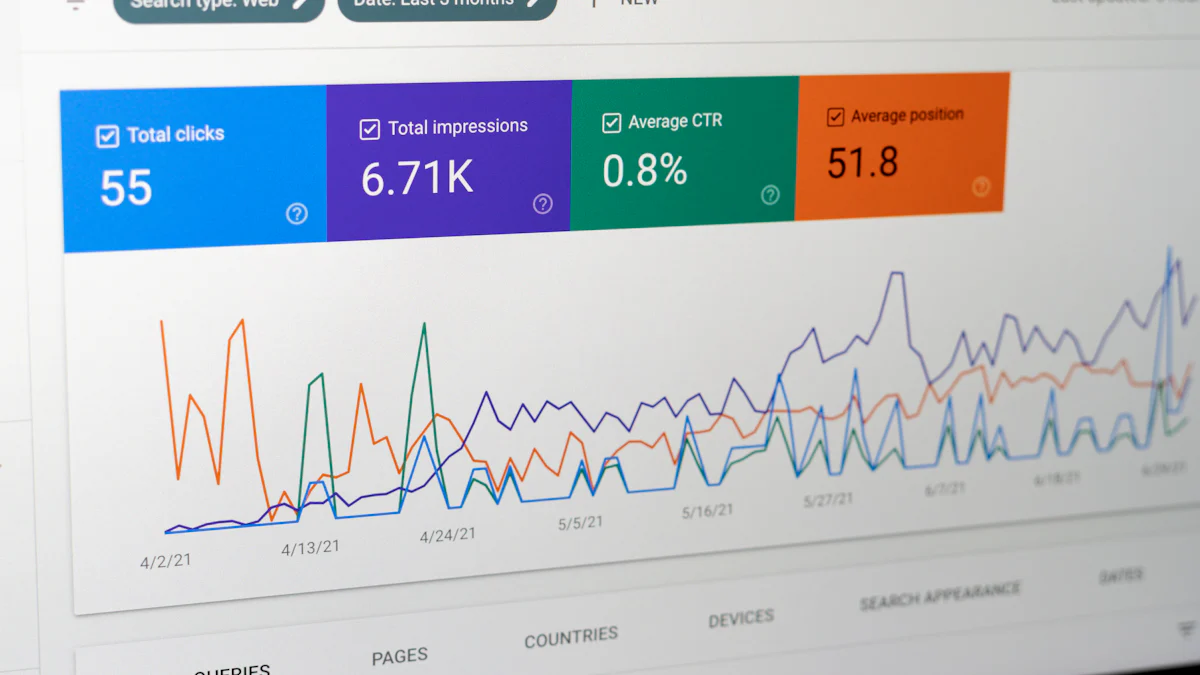Google Search Statistics You Need to Know Today

Google dominates the search engine market with an impressive 90.01% global share, according to Google Search Statistics. This means 9 out of 10 people worldwide rely on Google for their search needs. Every day, Google processes approximately 8.5 billion searches, contributing to a staggering 2 trillion searches annually. These numbers highlight how deeply Google is embedded in your daily life.
The table below illustrates the scale of Google’s search activity:
Daily Searches | Yearly Searches |
|---|---|
8.5 billion | 2 trillion |
Despite competition from platforms like Bing and Baidu, Google remains unmatched. Its vast search volume, as shown in Google Search Statistics, reflects its role as the go-to source for information globally.
Key Takeaways
Google processes approximately 8.5 billion searches daily, making it the primary source of information for billions of users worldwide.
Mobile searches account for over 63% of organic traffic, highlighting the importance of optimizing for mobile to reach users effectively.
Understanding Google search trends can enhance your SEO strategies, as 75% of users never go beyond the first page of search results.
Leveraging tools like Google Trends allows businesses to align content with audience interests and seasonal demands, boosting engagement.
Google's dominance in the search engine market emphasizes the need for businesses to maintain a complete online profile to increase visibility and customer visits.
Daily Google Search Statistics
How Many Searches Happen Per Day?
Every day, Google handles an astonishing 8.5 billion searches. This number reflects the platform's role as the primary source of information for billions of users worldwide. The sheer volume of daily searches highlights how deeply Google is integrated into your daily routine. Whether you're looking for quick answers, researching a topic, or exploring new trends, Google remains the go-to tool for search queries.
Breaking It Down: Searches Per Second, Minute, and Hour
To truly grasp the scale of Google’s activity, let’s break down the numbers. Every second, Google processes approximately 40,000 searches. This figure grows to 2.4 million searches per minute and an incredible 144 million searches per hour. The table below provides a clear breakdown:
Time Interval | Searches |
|---|---|
Per Second | 40,000 |
Per Minute | 2,400,000 |
Per Hour | 144,000,000 |
These numbers demonstrate the constant flow of Google search queries, showing how users rely on the platform every moment of the day.
Trends in Daily Search Volume Over Time
Google's daily search volume has grown significantly since its inception. In the late 1990s, the platform experienced exponential growth, with search volumes increasing by 17,000% between 1998 and 1999. By the early 2000s, growth rates stabilized to around 40-60% annually. In recent years, growth has slowed to a steady 10-15% per year. The table below illustrates this trend:
Year Range | Growth Rate (%) |
|---|---|
1998 - 1999 | 17,000 |
1999 - 2000 | 1,000 |
2000 - 2001 | 200 |
2001 - 2009 | 40% to 60% |
2009 - Present | 10% to 15% |
This steady growth reflects the increasing accessibility of the internet and the rise of mobile devices. Global events and technological advancements also influence search trends. For example, searches for "zero waste lifestyle" and "sustainable fashion" have surged due to growing environmental awareness. Similarly, terms like "mindfulness techniques" and "self-care routines" highlight a cultural shift toward mental well-being. Interest in innovations such as "artificial intelligence applications" and "blockchain technology" further showcases how societal curiosity drives search behavior.
Yearly Google Search Statistics and Trends
Total Yearly Searches: A Look at the Numbers
Google processes an astounding 2 trillion searches every year. This number reflects the platform's unmatched dominance in the search engine market. When you consider the global population, this means each person conducts hundreds of searches annually. These yearly figures highlight how essential Google has become in your daily life. Whether you are looking for answers, shopping online, or exploring new ideas, Google remains your go-to tool.
The yearly search volume also demonstrates the platform's ability to adapt to changing user needs. For example, searches for health-related topics surged during the COVID-19 pandemic. Similarly, queries about remote work tools and online learning resources increased significantly. These trends show how Google plays a critical role in responding to global events and societal shifts.
Growth in Yearly Search Volume Over the Past Decade
Over the past ten years, Google’s yearly search volume has grown steadily. In 2013, the platform processed around 1.2 trillion searches. By 2023, this number had risen to 2 trillion. This growth reflects the increasing accessibility of the internet and the widespread adoption of smartphones.
Mobile devices now account for more than half of all searches. This shift has contributed significantly to the rise in yearly search volume. Additionally, advancements in technology, such as voice search and artificial intelligence, have made it easier for you to find information quickly. These innovations continue to drive growth in search activity.
Regional Variations in Google Search Usage
Google’s popularity varies across different regions. In North America and Europe, the platform dominates the search engine market with over 90% market share. In contrast, regions like Asia and Africa show more diverse search engine usage due to local competitors. For example, Baidu leads in China, while Yandex is popular in Russia.
Despite these variations, Google remains the most widely used search engine globally. Its ability to provide localized results and support multiple languages makes it accessible to users worldwide. Whether you are in a major city or a remote village, Google ensures you can find the information you need.
Factors Driving Google Search Usage
The Rise of Mobile Searches
Mobile devices have transformed how you interact with Google. Over 63% of organic search visits in the U.S. now come from mobile devices. This shift highlights the growing importance of smartphones in your daily life. When you search for local businesses, 57% of these queries come from mobile devices or tablets. Additionally, 76% of people who search locally on their smartphones visit a physical location within 24 hours. This behavior shows how mobile searches directly influence offline actions.
Mobile technology also encourages shorter, more specific queries. Nearly 40% of mobile searches consist of three to four words. Features like "click to call" make it easier for you to connect with businesses directly from search results. In fact, 60% of smartphone users use this feature to contact businesses. These trends demonstrate how mobile devices have made Google searches more convenient and action-oriented.
The Impact of Voice Search and AI
Voice search is reshaping how you interact with Google. More than 50% of searches are now conducted through voice commands. This growth stems from the increasing use of smart devices and advancements in natural language processing. Voice search allows you to multitask while accessing information hands-free. For example, you can ask your voice assistant for directions or search for recipes while cooking.
AI plays a crucial role in improving the accuracy of voice search. It enables Google to understand conversational queries better, making your searches faster and more intuitive. Businesses are adapting to this trend by optimizing their online presence for voice search. As voice technology continues to evolve, it will further change how you search for information and interact with the digital world.
Global Internet Penetration and Accessibility
The expansion of internet access worldwide has significantly increased Google’s search volume. In many regions, affordable smartphones and data plans have made the internet more accessible. This accessibility allows more people to use Google for their daily searches. Whether you live in a bustling city or a remote village, Google ensures you can find the information you need.
In developing countries, internet penetration has opened new opportunities for education, commerce, and communication. People use Google to search for job opportunities, learn new skills, and connect with others. The platform’s ability to provide localized results in multiple languages makes it a vital tool for users across the globe. As internet access continues to grow, so will the number of searches conducted on Google.
The Role of Google in Everyday Life
Google plays a central role in your daily life, offering tools that simplify tasks, enhance productivity, and provide entertainment. Its search engine processes over 3.5 billion queries every day, making it the primary way you access information. Whether you need quick answers, product recommendations, or the latest news, Google ensures you find what you’re looking for in seconds.
Beyond search, Google’s services have become essential in communication and organization. Gmail, with 1.8 billion users, dominates email communication. It helps you stay connected with friends, family, and colleagues. Google Drive, which stores over 2 trillion files, supports your productivity by enabling file sharing and collaboration. Every week, users share 3 billion files through this platform, making it a cornerstone for teamwork and project management.
Google also enriches your leisure time. YouTube, with 2.3 billion monthly users, serves as a hub for entertainment and education. From tutorials to music videos, it offers endless content tailored to your interests. For navigation, Google Maps assists 1 billion users monthly. It helps you find the fastest routes, explore new places, and even locate nearby businesses.
These tools demonstrate how Google integrates into nearly every aspect of your life. It supports your work, learning, and relaxation while ensuring you stay connected and informed. Whether you’re planning a trip, managing a project, or simply searching for answers, Google remains an indispensable part of your routine.
Implications for Businesses and Users
Why These Statistics Matter for SEO
Google search statistics reveal critical insights for improving your SEO strategies. Ranking on the first page of google search results is essential, as 75% of users never go beyond it. Only 0.63% of users click on the second page, making first-page visibility crucial for driving traffic. Organic search plays a significant role in this process, with 93% of online experiences starting with a search engine like Google.
To improve your rankings, focus on user engagement metrics. Metrics like click-through rate (CTR), bounce rate, and time spent on your site directly impact your organic search performance. For example, 31% of SEO professionals consider CTR the most important ranking factor. By optimizing these metrics, you can enhance your visibility and attract more users.
Leveraging Google Search Trends for Digital Marketing
Google search trends offer valuable opportunities to refine your digital marketing strategies. Seasonal trends, such as holiday shopping or back-to-school sales, help you align your content with audience demand. Analyzing search volume data allows you to anticipate peak interest periods and plan campaigns effectively. For instance, tracking searches over time can reveal when customers are most likely to purchase specific products.
Google Trends also helps you identify emerging topics. By using this tool, you can generate content ideas that resonate with your audience. Predictive analysis enables you to stay ahead of market demands, ensuring your campaigns remain relevant. Businesses that leverage these insights can create targeted strategies, boosting both customer engagement and SEO performance.
Opportunities for Content Creation and Audience Engagement
Google search trends provide a wealth of inspiration for content creation. By analyzing trending searches, you can discover popular topics and align your content with current interests. Related queries often uncover hidden opportunities, allowing you to explore niche subjects that engage your audience. For example, the 'Forecast' feature in Google Trends predicts future trends, helping you create content that leads conversations in your industry.
Tailoring your content to audience preferences enhances engagement. Keyword research helps you identify the terms your audience searches for most frequently. Segmenting your audience based on their characteristics allows you to create personalized content. Post-creation analysis further refines your strategy by identifying what works and what doesn’t. These practices ensure your content remains relevant and impactful, driving organic search traffic and fostering loyalty.
Google search statistics highlight its role as the gateway to the digital world. With 92% of global search traffic, Google shapes how you access information and interact online. Its dominance provides insights into consumer behavior and societal trends, such as the rising interest in sustainable fashion.
For businesses, adapting to these trends is essential. A complete online profile increases your reputation by 2.7 times and boosts customer visits by 70%. Using tools like Google Trends helps you align content with seasonal interests and improve audience engagement. These strategies ensure you stay competitive in the ever-evolving digital landscape.
FAQ
What is the most searched topic on Google?
The most searched topics vary by year and region. Popular categories include trending news, celebrity updates, and "how-to" guides. For example, during global events like the Olympics or elections, related searches dominate. You can explore these trends using tools like Google Trends.
How does Google handle billions of searches daily?
Google uses advanced algorithms and massive data centers to process searches. Its AI-powered systems analyze your query, match it with indexed content, and deliver results in milliseconds. This efficiency ensures you get accurate answers quickly, even with billions of daily searches.
Why is mobile search so important?
Mobile searches account for over 63% of organic traffic. Smartphones make it easier for you to search anytime, anywhere. Features like location-based results and voice search enhance convenience. Businesses optimize for mobile to reach users effectively and improve engagement.
How can I use Google Trends for my business?
Google Trends helps you identify popular topics and seasonal trends. By analyzing search data, you can create relevant content, plan marketing campaigns, and predict customer behavior. This tool ensures your strategies align with what your audience cares about most.
Does Google prioritize local search results?
Yes, Google prioritizes local results for location-based queries. For example, when you search for "restaurants near me," Google uses your location to show nearby options. Businesses can optimize their profiles on Google My Business to appear in these results and attract local customers.



